SUBJECTS
GRADE
Show Results
Egyptian Pyramids

Lesson Summary
- Identify several Egyptian pyramid structures and explain how they evolved over time.
- Represent various shapes and facts about the pyramids through dance.
Lesson Plan and Procedure
Lesson Key Facts
- Grade(s): 6
- Subject(s): Dance, Social Studies
- Duration of lesson: 40 minutes
- Author(s): Jana Shumway
Experience/Identify
Show visuals of the mummy nicknamed Ginger, the mastaba tombs, the step pyramids, the pyramids of Giza, and the Valley of the Kings.
Display cards with various kings/pharaohs.
Display cards with various time periods.
Have the students guess the order in which the landmarks or artifacts came into being and how they evolved over time by matching the picture to the correct time period and king/pharaoh.
| Artifact or Landmark | Time Period | King/Pharaoh |
|---|---|---|
| Ginger | Earliest Times | |
| Mastaba Tombs | 3000 BC | |
| Step Pyramids | 2700 BC | King Djoser |
| Pyramids of Giza | 2500 BC | Pharaoh Khufu |
| Valley of the Kings | 1500 BC | King Tut (Tukankhamen) |
Give a brief introduction to each of these artifacts or landmarks and the reasoning behind the order they came in.
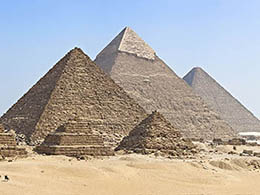
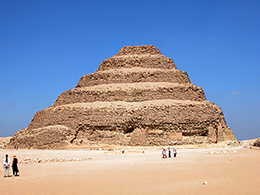
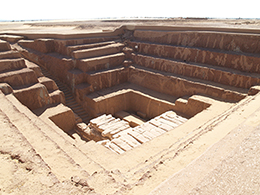
Explore/Investigate
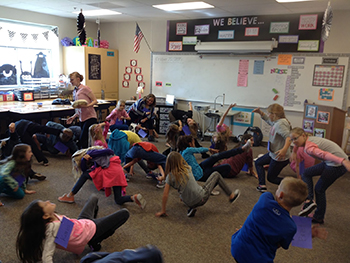 Show the appropriate picture for each of these artifacts or landmarks being explored before exploring them through dance.
Show the appropriate picture for each of these artifacts or landmarks being explored before exploring them through dance.
Ginger
Play “Night Ride Across the Caucasus” by Loreena McKennitt.
Have half of the class lie down in a “sand pit” to create the mummified bodies, making straight, stiff shapes. Have the other half of the class represent the sand moving around them by swirling, turning, and twisting. Switch roles.
Mastaba Tombs
Have half of the class lie down like mummies, pretending that there are walls all around them. Have the other half of the class make Egyptian relief shapes around them. (For example: head sideways, feet sideways, hips forward, shoulders forward, hands offering, always showing all four limbs.)
Create/Perform
Step Pyramids
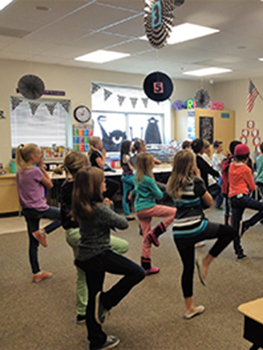
Have the students get into groups of five and create a variety of five step pyramids. (They do not need to make a traditional pyramid—push their creativity with ideas like just using their arms, backs, heads, or feet instead.)
Have the students look around (while holding their shapes) at all the different pyramids in the room. Comment, as appropriate, on the creative choices the students made in making their step pyramids.
Pyramids of Giza
Remain in groups of five and create pyramids with four flat walls. Again, encourage creativity (upside-down walls, making the wall with a different body part, and so on). The fifth member of the group can be Pharaoh Khufu.
Have the students look around (while holding their shapes) at all the different pyramids in the room. Comment, as appropriate, on the creative choices the students made in making the pyramids of Giza.
Valley of the Kings
Split into random groups of different sizes to create the inside of the Valley of the Kings. Have each group create a short movement phrase, knowing that someone will be navigating through from the following ideas:
- Secret passageways
- Secret doors
- Collapsing bridges
- Fake pharaohs
- Dead ends
- False treasures
Use the drum as accompaniment.
After they have created their movement phrase, either you or a student try to make it through all the obstacles in the Valley of the Kings to find the pharaoh and his treasures.
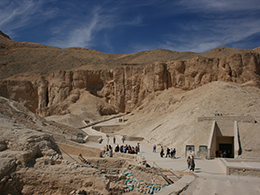
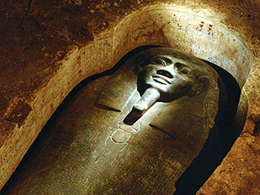
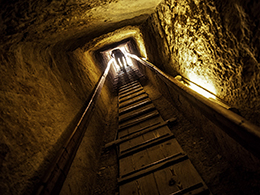
Connect/Analyze
Have the students in their groups come up with a short narration (like a sports announcer) for someone trying to go through the Valley of the Kings. In this narration, they need to reference another time period’s pyramid and how that contributed to the Valley of the Kings. Repeat the Valley of the Kings section, allowing each group to comment on what is happening as you go through.
Learning Objectives
- Understand how ancient civilizations developed.
- Understand how ancient civilizations contributed to the modern world.
- Identify how manmade structures changed over time.
- Create new shapes based on others but in a different, creative way.
- Recognize cultural meaning in dance.
- Use cultural meaning to enhance dance.
Utah State Board of Education Standards
This lesson can be used to meet standards in many grades and subject areas. We will highlight one grade’s standards to give an example of application.
Grade 6 Social Studies
Standard 6.1.5: Use primary and secondary sources to compare the cultures of three civilizations found in different regions of the world and identify examples of cultural expression (for example, architecture, writing, philosophy, artwork).
Standard 6.1.1: Discern characteristics needed for the transformation from simple societies to civilizations, and compare those characteristics in at least three different ancient civilizations found in different regions of the world (for example, Mesopotamia, Egypt, Indus River Valley, China, Inca, Aztec, Persia, Greece, Carthage, Gupta, Rome).
Standard 6.1.4: Identify some of the economic systems and technologies (for example, irrigation, writing systems, farming techniques, trading and bartering, coins and currency) created by three civilizations found in different regions of the world, and categorize how they met specific human needs or wants.
Grade 6 Dance
Standard 6.D.CR.1: Demonstrate openness, willingness, and persistence in trying new ideas, methods, and approaches when creating dance.
Standard 6.D.CR.3: Develop a dance study that communicates personal or cultural meaning.
Equipment and Materials Needed
- Word strips of time period, pharaoh, and pyramids
- Music track: “Night Ride Across the Caucasus” by Loreena McKennitt
- Drum
- Images of the following:
- Mummy Ginger
- Mastaba tombs
- Step pyramids
- Pyramids of Giza
- Valley of the Kings
Additional Resources
For more information and pyramid facts, check out the following:
- http://www.sciencekids.co.nz/sciencefacts/engineering/egyptianpyramids.html
- http://www.ducksters.com/history/ancient_egyptian_pyramids.php
Image References
Image 1: BYU Arts Bridge Student Blogs (http://education.byu.edu/arts/bridge/2016).
Image 2: Wikipedia (https://en.wikipedia.org/wiki/Giza_pyramid_complex#/media/File:All_Gizah_Pyramids.jpg).
Image 3: Wikimedia Commons (https://commons.wikimedia.org/wiki/File:Egypt-12B-021_-_Step_Pyramid_of_Djoser.jpg).
Image 4: Wikimedia Commons (https://commons.wikimedia.org/wiki/File:Balat_mastaba_tomb_1.jpg).
Images 5–6: BYU Arts Bridge Student Blogs (http://education.byu.edu/arts/bridge/2016).
Image 7: Flickr (https://www.flickr.com/photos/supermac/3334775629).
Image 8: XciteFun (http://forum.xcitefun.net/inside-egyptian-pyramid-rare-and-unique-pictures-t8803.html).
Image 9: Flickr (https://www.flickr.com/photos/m1key-me/19754932336).

www.education.byu.edu/arts/lessons
 Download
Download